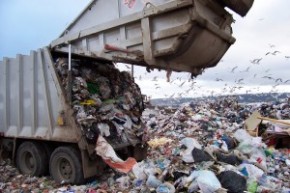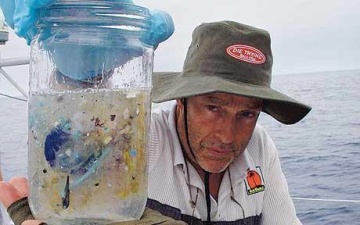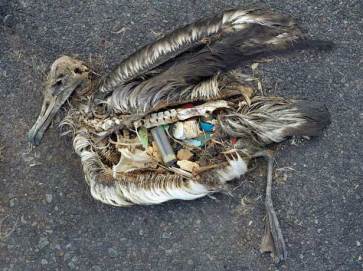The USEE Staff
Have you ever wondered where your empty water bottle goes after you throw it in the trash? The bottle could end up buried at a landfill, burned in an incinerator, or it could end up belted around a young sea turtle. However, there is another place you may never expect the plastic to end up: inside your own body. Nature functions by building up and breaking down, and we are continually putting trash in the earth that nature cannot digest. An average American generates 4.6 pounds of trash per day, which translates to 251 million tons per year. (EPA) This is about twice as much trash as other countries accumulate. The biggest contributor to our dissipating eco systems is plastic; a substance that is totally at odds with the environment. It’s critical that we take responsibility for the trash we produce if our species and eco systems are to survive.
 The majority of trash in America ends up being sent to a landfill. Landfills are not created to break down trash; they are created to bury it. Landfills are the largest human-related source of methane in the United States. Methane is a greenhouse gas 21 times more potent than carbon dioxide. By sending excessive amounts of trash to landfills, we are polluting the air that we have to breathe in order for us to survive.
The majority of trash in America ends up being sent to a landfill. Landfills are not created to break down trash; they are created to bury it. Landfills are the largest human-related source of methane in the United States. Methane is a greenhouse gas 21 times more potent than carbon dioxide. By sending excessive amounts of trash to landfills, we are polluting the air that we have to breathe in order for us to survive.When the trash starts to overflow in the landfill, some cities have it sent to an incinerator where it can be burned. There is no sorting process before the trash is burned; everything goes in. When plastics are incinerated, the chemicals that are released are known as dioxins. Dioxins can enter the body by inhalation, or by consuming animals that have inhaled the dioxins. “When dioxins enter the body they can cause skin rashes, mild liver damage, cardiovascular deterioration, infertility in men and women, and degeneration of the endocrine system.” (Banerjee 3) It is nearly impossible to eliminate these dioxins from our bodies. However, women can get rid of them by having a baby. Sadly, these dioxins are passed on to the infant and can cause severe deformities, and a shorter life for the child.

In 1997, Captain Charles Moore was sailing through the North Pacific Gyre when he made a heartbreaking discovery. In Moore’s article Trashed, he said, “As I gazed from the deck at the surface of what ought to have been a pristine ocean, I was confronted as far as the eye could see, with the sight of plastic.” Somewhere between 70 and 80 per cent of the trash accumulating in the ocean is post-consumer waste from the land. Typically, the trash is swept into the ocean by storms and wind. The wind-driven, swirling current of the North Pacific Gyre gathers plastics and other trash, slowly moving it towards the center of the region, creating an island. Curtis Ebbesmeyer, a leading flotsam expert, named this accumulation of trash the Great Pacific Garbage Patch (GPGP). The GPGP might be the biggest body of pollution in the world today. The patch mostly consists of pelagic plastics, formed from plastic bags and plastic bottles. Some researchers and scientists have estimated the patch to be twice the size of Texas, but no one really knows. The sun breaks down the plastics into smaller and smaller pieces, which makes it difficult to judge the size of the patch. Since Moore’s discovery, he founded the Algalita Marine Research Foundation. Moore has revealed that in numerous sampled areas, plastic concentration is 7 times higher than Zooplankton. Basically, there is more trash than life in parts of our oceans.
 “Whether it’s an algae-sifting whale or a fish-eating seal, small pieces of plastic are mistaken for food at all levels of the food chain. Greenpeace estimates that one million birds and 100,000 marine mammals die in the Garbage Patch each year.” (Dumas 2) Most people don’t realize that what they do can affect the environment thousands of miles away. Essentially, these plastics can and do end up in the human body by consuming seafood. Eskimo women in Alaska are being told to give their babies formula because their milk is toxic due to eating fish that are high up on the food chain. However, everyone in the population today has plastic chemicals in their body. If the earth can’t digest plastics, neither can humans.
“Whether it’s an algae-sifting whale or a fish-eating seal, small pieces of plastic are mistaken for food at all levels of the food chain. Greenpeace estimates that one million birds and 100,000 marine mammals die in the Garbage Patch each year.” (Dumas 2) Most people don’t realize that what they do can affect the environment thousands of miles away. Essentially, these plastics can and do end up in the human body by consuming seafood. Eskimo women in Alaska are being told to give their babies formula because their milk is toxic due to eating fish that are high up on the food chain. However, everyone in the population today has plastic chemicals in their body. If the earth can’t digest plastics, neither can humans.In the documentary Garbage Island, Moore said, “The earth can’t spit it [plastic] out, unless we stop putting it in.” So what is the best way to dispose of plastics? The answer is very simple: recycle. Recycling reduces the amount of methane emissions that are produced in landfills, leading to much cleaner air for the environment and for us to breathe. Recycling also reduces the amount of dioxins released from burning plastics in incinerators; which will improve the health of species and environments near by. Not only does recycling protect and conserve the land and animals, it also helps us sustain human life. Altogether, recycling gives generations to come an opportunity to see and learn about all the beautiful creations of our world.
Works Cited
Banerjee, Tirtho. “Molecules of Death.” Down to Earth. Aug. 31 2001: 32-39. SIRS Issues Researcher. Web. 01 Dec 2013.
Dumas, Daisy. “Landfill-On-Sea.” Ecologist (London, England) Vol. 37, No. 7. Sept. 2007: 34- 37. SIRS Issues Researcher. Web. 01 Dec 2013.Charles Moore, “Trashed. Across the Pacific Ocean, plastics, plastics, everywhere.”Natural History magazine. November 1993. Web. 3 December 2013.
U.S. Environmental Protection Agency. “Municipal Solid Waste.” Website. 2 Dec 2013. Web. 4 Dec 2013.
VICE Production ” Garbage Island: An ocean full of plastic.)” Documentary. YouTube. YouTube, 6 Sept. 2012. Web. 3 Dec. 2013.
-Maizy Anderson
No comments:
Post a Comment